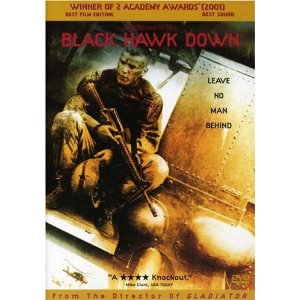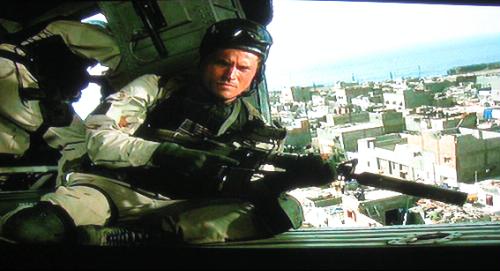 Director Ridley Scott seems to do well in bringing nightmarish fictional dystopias to life, so he was an inspired selection for Jerry Bruckheimer and the producers of the movie version of Mark Bowden’s incredible non-fiction book,. After all, the parched arena of Gladiator or the nightmare society of Blade Runner are practically Disneyland compared to the Hobbesean state of nature that Somalia has been for many decades now. And Bowden told the story with rare craft and integrity.
Director Ridley Scott seems to do well in bringing nightmarish fictional dystopias to life, so he was an inspired selection for Jerry Bruckheimer and the producers of the movie version of Mark Bowden’s incredible non-fiction book,. After all, the parched arena of Gladiator or the nightmare society of Blade Runner are practically Disneyland compared to the Hobbesean state of nature that Somalia has been for many decades now. And Bowden told the story with rare craft and integrity.
Bowden’s book may be the best single work of small-unit military history ever written, full stop. Bowden applied the techniques he used as an old-style shoe-leather reporter for the Philadelphia Enquirer to understanding and documenting the battle that took place on Sunday, October 3, 1993. He did it first for the newspaper and its website (and word of the website spread like wildfire through the special operations community at the time, which brought Bowden more interviewees). The book followed.
The military produced classified and unclassified studies on the battle as well, and some participants have told their stories also. We’ve read them all. It is only Black Hawk Down which shows a full understanding of the battle.
The movie builds on this clarity and adds stark visuals, a rapid pace and haunting Arabic music, and extremely skillful acting by a mixed cast of newcomers and established character actors.
To keep the movie moving, it’s much more compressed than the book is, and it needs a long run-up with lots of text on screen to explain to American viewers what they were about to see.
The political aspects of the mission are downplayed in the movie; the disastrous leadership at the National Command Authority level cost Secretary of Defense Les Aspin his job, and his health deteriorated precipitously. In Congress, he had been a firm voice for the military and military reform; in the Pentagon he became an unsuccessful shock absorber between an anti-military presidency and armed forces who had little respect and trust in his boss — and that was before October 3, 1993.
Some people are shocked by the violence in the movie. Read the book… the movie’s violence, for example the death of Tim Martin (whom we knew slightly in 10th SF, before he went to selection) is actually toned down from what the Rangers and special operators experienced.
The US Army assisted in making the film, and as a result, the weapons, uniforms and aircraft are dead-zer0 on for the period (yes, our M4s had fixed carrying handles still in 1993). The tactics are simplified but accurate… an actual mission FRAGO or briefback would bore the moviegoing public to tears. The effects of combat — sound, light, and psychological — are all well-modeled. In an Amazon review, a period 2nd Rangers veteran said this about that:
It’s very accurate as far as weapons, equipment, uniforms, etc. They used the exact helicopters that were used in the original mission in 1993 with the 160th SOAR.
The whole movie I was searching for inaccuracies. Want to know what I came up with? They had their names written in marker on their Kevlar helmets (this was done so the audience could quickly tell who’s who) we wrote our names on the helmet band. The chin straps on the Kevlar helmets were not taped up (As soon as I got to Ranger Battalion we had to taped up and tie down certain pieces of equipment and this was one of them), they wore dog tag silencers (in Ranger Battalion I was told to get them off and tape em up with 100 MPH tape as soon as I got there), and sometimes they said each others names on the radios instead of call signs (once again this was done for the audience). So as you can see I was really reaching there.
RLTW, guy. He also said, clearly referring to a movie that gave its name to generations of no-hopers who were about to be dropped from RIP, ROP, SFAS, and other elements’ selection programs: “Combat is not one guy running around killing people by the hundreds with a head band on. They made it a real as you could get it on the screen.” Bravo. (Gee, we need to find some more of this guy’s Amazon reviews, he’s clearly a genius as he agrees with us.
This was one of the last theatrical movies made to show US forces in a positive light. Because it stuck so well, for a movie, to the facts uncovered so thoroughly by Mr Bowden, it could scarcely have failed to do so. It is a ripping tale of courage, adventure, sacrifice, and that uniquely American gift for combat improv. If you haven’t seen t, well, Amazon has a copy for you.
If you want to know more about Operation Gothic Serpent and the real men depicted in the movie, get Bowden’s book. Another good book about the operation is In the Company of Heroes by Michael Durant, the helicopter pilot who survived his shootdown and cruel Somali captivity.

Kevin was a former Special Forces weapons man (MOS 18B, before the 18 series, 11B with Skill Qualification Indicator of S). His focus was on weapons: their history, effects and employment. He started WeaponsMan.com in 2011 and operated it until he passed away in 2017. His work is being preserved here at the request of his family.

